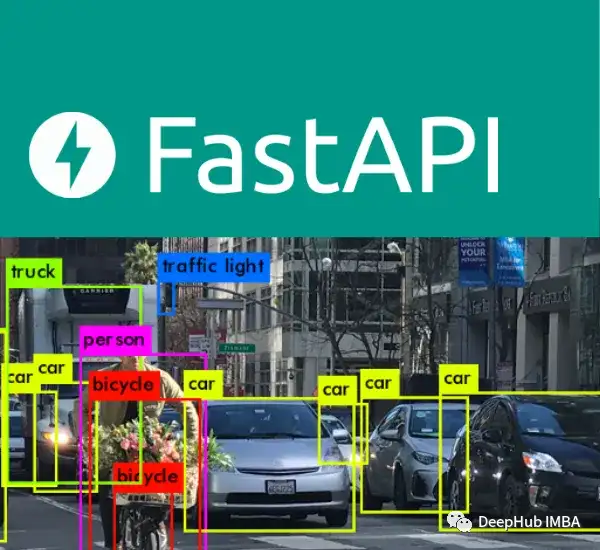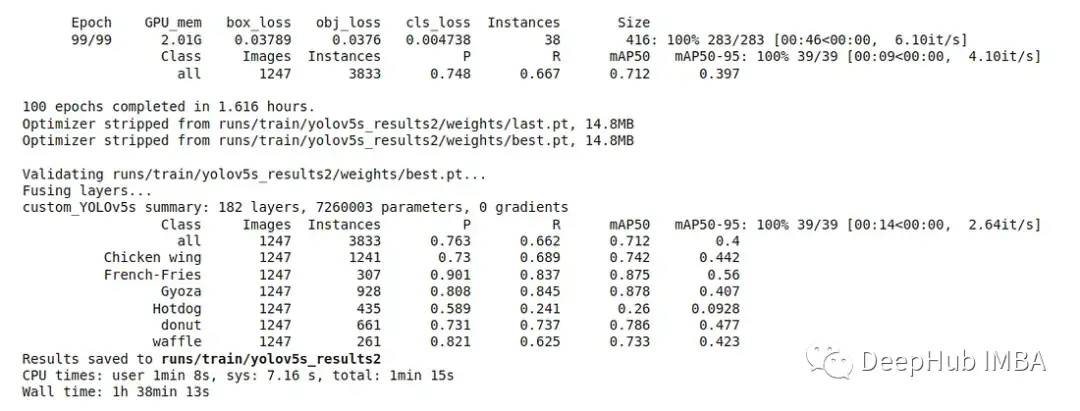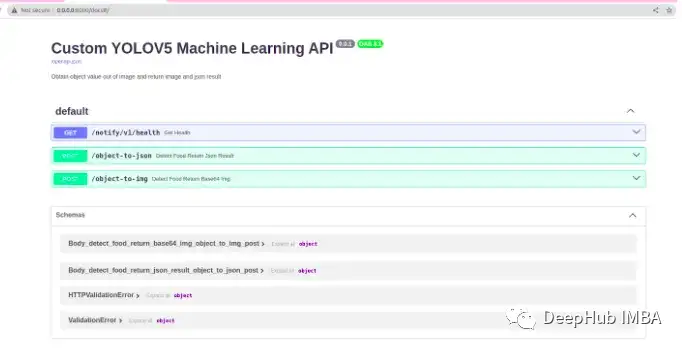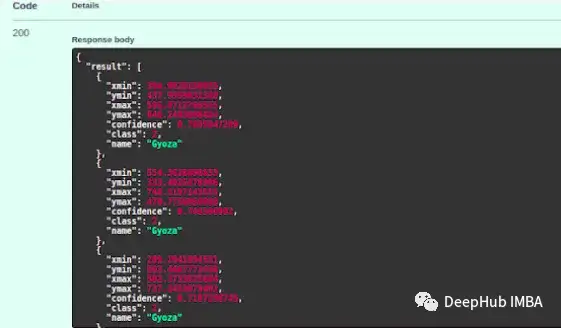使用FastAPI部署Ultralytics YOLOv5模型
前言 YOLO是You Only Look Once(你只看一次)的缩写,它具有识别图像中的物体的非凡能力,在日常应用中会经常被使用。所以本文将介绍如何使用FastAPI的集成YOLOv5,这样我们可以将YOLOv5做为API对外提供服务。
本文转载自Deephub Imba
作者:auliyafirdaus
仅用于学术分享,若侵权请联系删除
欢迎关注公众号CV技术指南,专注于计算机视觉的技术总结、最新技术跟踪、经典论文解读、CV招聘信息。
【CV技术指南】CV全栈指导班、基础入门班、论文指导班 全面上线!!

Python有几个web框架,其中最突出的两个是Flask和FastAPI。Flask是一个轻量级且灵活的框架,非常适合中小型web应用程序,而FastAPI是一个相对较新的框架,旨在快速轻松地构建api。
FastAPI
FastAPI是一个现代的web框架,可以用于基于OpenAPI标准使用Python 3.6+构建api。FastAPI提供的代码只需进行最小的调整即可用于生产环境。FastAPI与ASGI(异步服务器网关接口)的集成使其成为最快的Python框架之一。
设置环境
建立虚拟环境是软件开发和数据科学中至关重要的第一步。虽然并不总是强制性的,但强烈建议这样做。虚拟环境隔离了项目的依赖项,确保了稳定性和兼容性。这种做法简化了版本管理,使项目更有组织性和可维护性。简而言之,它是提高项目质量的最佳实践。
python3 -m venv my_project然后使用命令激活来启动虚拟环境
my_project/bin/activate训练定制YOLOv5模型
我们这里不介绍详细的训练流程,第一是因为官方有代码可以直接使用,第二是因为我们主要介绍部署的步骤。
这里使用6种食物数据集进行训练,这些数据集在Roboflow上进行了预先注释,可以对鸡翅,炸薯条,饺子,热狗,甜甜圈,华夫饼图像进行分类。如果你有自己的图像并想要创建一个数据集,你也可以在Roboflow上手动注释它们。
python train.py - img 416 - batch 16 - epochs 100 - data {dataset.location}/data.yaml - cfg ./models/custom_yolov5s.yaml - weights '' - name yolov5s_results - cache只需要上面一句就可以进行训练,结果如下
精度(P): 0.763(所有类别的平均值)
召回率(R): 0.662(所有类别的平均值)
mAP50 (IoU 0.5的平均精度):0.712(所有类别的平均值)
mAP50-95: 0.4(所有类别的平均值)


使用FastAPI进行模型推理
下面是一个最简单的项目目录结构模板:
├── README.md
├── main.py # The main program
├── model
│ ├── __init__.py
│ └── best.pt # Custom training model
├── requirements.in # Used to generate requirements.txt
├── requirements.txt # Install dependencies: pip install -r requirements.txt
├── segmentation.py # Importing the local YOLOv5 and resize images
└── yolov5 # You can obtain this from https://github.com/ultralytics/yolov5main.py
这是一个有3个函数:
@app.get(' /notify/v1/health '),这是检查应用程序运行状况的端点。它返回一个带有消息“OK”的JSON响应。这个端点用于检查Kubernetes的readinessProbe和liveessprobe。
@app.post(" /object-to-json "),这个端点处理图像中对象的检测,并以JSON格式返回结果。它需要一个图像文件作为输入。
@app.post(" /object-to-img "),这个端点执行对象检测并返回带有注释对象的图像。它还需要一个图像文件作为输入,并将带注释的图像作为响应发送。
#import statement
from fastapi import FastAPI, File #building the API
from segmentation import get_yolov5, get_image_from_bytes #segmentation functions
from starlette.responses import Response #handling API responses
import io
from PIL import Image
import json
from fastapi.middleware.cors import CORSMiddleware
#initialize and obtain the model
model = get_yolov5()
#FastAPI application setup
app = FastAPI(
title="Custom YOLOV5 Machine Learning API",
description="""Obtain object value out of image
and return image and json result""",
version="0.0.1",
)
#CORS (Cross-Origin Resource Sharing) middleware, allows the API to be accessed from different domains or origins.
origins = [
"http://localhost",
"http://localhost:8000",
"*"
]
app.add_middleware(
CORSMiddleware,
allow_origins=origins,
allow_credentials=True,
allow_methods=["*"],
allow_headers=["*"],
)
#Checking health of application, returns “OK” JSON response
@app.get('/notify/v1/health')
def get_health():
"""
Usage on K8S
readinessProbe:
httpGet: path: /notify/v1/health
port: 80
livenessProbe:
httpGet:
path: /notify/v1/health
port: 80
:return:
dict(msg='OK')
"""
return dict(msg='OK')
@app.post("/object-to-json")
async def detect_food_return_json_result(file: bytes = File(...)):
input_image = get_image_from_bytes(file)
results = model(input_image)
detect_res = results.pandas().xyxy[0].to_json(orient="records") # JSON img1 predictions
detect_res = json.loads(detect_res)
return {"result": detect_res}
@app.post("/object-to-img")
async def detect_food_return_base64_img(file: bytes = File(...)):
input_image = get_image_from_bytes(file)
results = model(input_image)
results.render() # updates results.imgs with boxes and labels
for img in results.imgs:
bytes_io = io.BytesIO()
img_base64 = Image.fromarray(img)
img_base64.save(bytes_io, format="jpeg")
return Response(content=bytes_io.getvalue(), media_type="image/jpeg")segmentation.py定义了2个方法:
1、Get_yolov5():这是yolov5可以使用定制模型的地方。
Model = torch.hub.load('。/yolov5 ', ' custom ', path= ' ./model/best.pt ', source= ' local '):它从本地目录加载自定义yolov5模型。' custom '参数指定模型架构,' ./model/best.pt '是定制训练模型文件的路径,' source '表示模型位于本地。conf = 0.5:设置对象检测的置信度阈值。只有置信水平大于0.5的对象才会被包含在检测结果中。
2、Get_image_from_bytes():调整图像大小以确保与模型期望的兼容性。
input_image = image .open(io.BytesIO(binary_image)).convert(" RGB "):它读取二进制图像数据并将其转换为RGB格式的PIL (Python Imaging Library)图像。它计算图像的宽度和高度,并确定调整因子以适应指定的max_size。Resized_image是通过根据计算的尺寸调整输入图像的大小来创建的,确保它不超过最大大小。
启动项目
在终端上输入以下命令
uvicorn main:app — reload — host 0.0.0.0 — port 8000成功运行程序时,它将看起来像这样

测试结果
在浏览器中打开http://127.0.0.1:8000/docs#/。你应该看到有3个端点的Open API文档:

/notify/v1/health 返回一个JSON响应,其中包含消息' OK '。你可以通过点击try it out并执行来检查,输出如下:

/object-to-json 处理图像中对象的检测,并以JSON格式返回结果。它需要一个图像文件作为输入。

/object-to-img 执行对象检测并返回带有注释对象的图像。它还需要一个图像文件作为输入,并将带注释的图像作为响应发送。

这样我们的程序就完成了
总结
这里我们看到了yolov5模型的部署的完整过程,并且这个过程是可以应用到生产环境的。但是这里我们发现了一个新的命令 'uvicorn'.
Uvicorn 是基于 uvloop 和 httptools 构建的非常快速的 ASGI 服务器。因为 Uvicorn 是一个非常快速、可靠且易于使用的 ASGI 服务器,可以在处理大量并发连接时保持稳定和高效。Uvicorn 还支持 WebSocket 和 HTTP/2 等新特性,它符合 FastAPI 提倡的现代 Web 开发理念。所以使用 Uvicorn 作为 FastAPI 的 Web 服务器是一个很好的选择。
欢迎关注公众号CV技术指南,专注于计算机视觉的技术总结、最新技术跟踪、经典论文解读、CV招聘信息。
【技术文档】《从零搭建pytorch模型教程》122页PDF下载
QQ交流群:470899183。群内有大佬负责解答大家的日常学习、科研、代码问题。
其它文章
LSKA注意力 | 重新思考和设计大卷积核注意力,性能优于ConvNeXt、SWin、RepLKNet以及VAN
CVPR 2023 | TinyMIM:微软亚洲研究院用知识蒸馏改进小型ViT
ICCV2023|涨点神器!目标检测蒸馏学习新方法,浙大、海康威视等提出
ICCV 2023 Oral | 突破性图像融合与分割研究:全时多模态基准与多交互特征学习
HDRUNet | 深圳先进院董超团队提出带降噪与反量化功能的单帧HDR重建算法
南科大提出ORCTrack | 解决DeepSORT等跟踪方法的遮挡问题,即插即用真的很香
1800亿参数,世界顶级开源大模型Falcon官宣!碾压LLaMA 2,性能直逼GPT-4
SAM-Med2D:打破自然图像与医学图像的领域鸿沟,医疗版 SAM 开源了!
GhostSR|针对图像超分的特征冗余,华为诺亚&北大联合提出GhostSR
Meta推出像素级动作追踪模型,简易版在线可玩 | GitHub 1.4K星
CSUNet | 完美缝合Transformer和CNN,性能达到UNet家族的巅峰!



【推荐】国内首个AI IDE,深度理解中文开发场景,立即下载体验Trae
【推荐】编程新体验,更懂你的AI,立即体验豆包MarsCode编程助手
【推荐】抖音旗下AI助手豆包,你的智能百科全书,全免费不限次数
【推荐】轻量又高性能的 SSH 工具 IShell:AI 加持,快人一步
· 全程不用写代码,我用AI程序员写了一个飞机大战
· DeepSeek 开源周回顾「GitHub 热点速览」
· 记一次.NET内存居高不下排查解决与启示
· MongoDB 8.0这个新功能碉堡了,比商业数据库还牛
· .NET10 - 预览版1新功能体验(一)